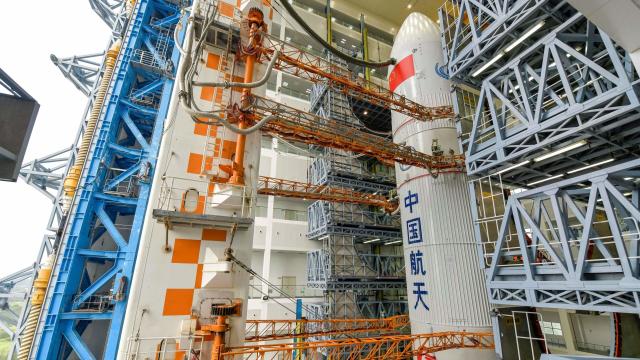The China National Space Administration’s mission to bring chunks of the Moon back to Earth for the first time in decades will kick off this week, with the Chang’e-5 spacecraft slated to launch on today from Wenchang Space Launch Centre on Hainan Island.
Chang’e-5 will launch on a Long March 5 rocket at approximately 4:35 a.m. local time (or 7:35 a.m. AEDT on Tuesday for those of us in Australia.) According to Nature, the craft was actually supposed to take off in 2017 but was delayed after a rocket engine failure. Onboard is a lander, ascender, orbiter, and returner; the first two components will descend to the Lunar surface near Mons Rümker, a volcanic formation roughly 1,300 metres high.
A live feed of the launch is below:
The total time Chang’e-5 is projected to spend on the Lunar surface is approximately two weeks (a Lunar day), according to Nature, and will involve drilling around two metres to return 2 kilograms of material. After the lander’s ascent and meeting with the orbiter, Chang’e-5 will ferry the Moon rocks and dust back to a landing site in Inner Mongolia. The samples could help scientists better understand the Moon’s volcanic history; while prior samples have indicated that the Moon stopped spewing lava 3.5 billion years ago, according to Nature, there is also evidence that the timeline could be more like one or two billion years ago. The implications of any surprising findings would inform research into the history of the Moon and the Earth, as well as the formation of extraterrestrial bodies.
According to USA Today, U.S. law prohibits most space cooperation with China outside of the International Space Station. Most of the samples will go to the Chinese Academy of Sciences National Astronomical Observatory of China (NAOC) in Beijing, Nature wrote, and it’s unclear whether any arrangement can be reached for U.S. scientists to gain access.
Per the New York Times, Chang’e-5 would place China as the third nation with their own Moon chunks, following NASA and Soviet missions no more recent than 1976. While China has sent prior missions to the moon — including Chang’e-4, which became the first craft to soft land on the dark side of the Moon in 2019 — returning the samples is more technically complicated than those and will require the CNSA to demonstrate they have mastered a number of engineering problems ranging from heat control to Lunar launching. The single Lunar day landing window is important, for example, as Chang’e-5 is not designed to survive the Moon’s frigid nights.
“This is a really audacious mission,” NASA deputy chief scientist David S. Draper told the Times. “They’re going to move the ball down the field in a big way with respect to understanding a lot of things that are important about lunar history.”
“We launch rockets on the ground with relatively mature technology, but we are using the lander as the launching platform on the lunar surface,” Yu Dengyun, deputy chief designer of CNSA lunar missions, said on state TV, according to the Times. “How to dissipate heat, how to divert flows and how to control the rising process are what we have never done before. These are hard nuts to crack.”
Mons Rümker is a volcanic formation and therefore “younger” than regions of the Moon observed in prior missions, meaning the Chang’e-5 landing site is “extremely wisely picked,” University of Münster geologist Harald Hiesinger told Nature.
According to the Times, Brown University geological sciences professor James W. Head III said that the findings could have “implications way beyond the moon,” as scientists don’t currently know why the Moon managed to remain hot for at least three billion years after its formation. Head said that concentrations of the radioactive element thorium could indicate whether the Moon’s volcanic activity was fuelled by heat released during the thorium’s long decay process. It’s possible that the samples could challenge that theory or even indicate the Moon still has some heat left in it, Head told the paper.
The mission is “indeed challenging,” Harvard-Smithsonian Centre for Astrophysics astronomer Jonathan McDowell told USA Today, but CSNA has previously pulled off equivalents to every stage but the actual sample collection and Lunar launch.
“As a result of this, I’m pretty optimistic that China can pull this off,” McDowell added.
